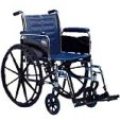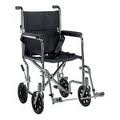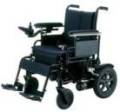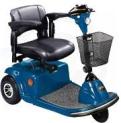Mobility Chairs or WheelChair
Selection Basics
The variety of choices in mobility chairs or wheelchairs can be a mind-boggling. Is this decision process in you or a loved one’s future and you have no idea where to begin? There are so many types and styles…what should I look for? What do I need? What is the difference in their uses and physical requirements? Here are a few things to be aware of before you start looking. Keep in mind there are predominately two different kinds of wheelchairs …(push)manual mobility chairs and electric powered chairs.
First is Comfort. Try out several models and “feel” their fit for you. You will probably want a seat cushion to help prevent pressure sores. Will your feet reach the floor comfortably for self propelling with the cushion in place? Consequently, is the seat height adjustable? The rear wheels are generally 24” in diameter and may need to be smaller or larger to get a 90 degree angle with your knees bent.
Is the seat width right for you? The standard chair seat width is 18”. An easy way to determine your width requirement is to place a solid object, like a book, on both sides of your hips while sitting and measure the distance between the books. You may want to add an inch or two for heavier, cold weather clothing.
Are footrests, leg rests and arm rests adjustable, moveable, and/or removable? How easily are these changes made?
Are arm and leg rests padded?
Check the mobility chairs weight limitations if you are heavy.
Can you easily get into and out of the chair?
Your health care professional or physical therapist will undoubtedly have many more suggestions for you to think about depending on your disability. Be sure and question them both.

Standard Manual Mobility Chairs are, by far, the most
common and are designed for self
propelling with your arms and hands. They require upper body strength
in shoulders, arms, hands and trunk. Some are lighter weight than
others....the lighter weight is your best choice for occasional use.
They generally fold for easy storage and weigh about 30 pounds making
them easier for self propelling or pushing by the caregiver. This chair
is ideal for those going out for the day in a car or for someone who
can’t walk as
far as they used to. A fixed frame or rigid mobility chair may be more
comfortable for a larger person, however, some steel framed rigid chairs
can weigh as much as 50 pounds. The extra weight makes them more
difficult to propel. They may or may not be folding. Try out
both….give them a push with your hands and see how far you will roll.

Transport Chairs weigh about 20 pounds and can only be pushed by a caregiver due to their small back wheels. They are compact, portable, foldable, and easily stored...very good for small spaces like hallways, apartments and cruise ships. Powered transport chairs are available but must be disassembled for storage by removing the base, seat and battery pack.

Electric Wheelchairs are very similar to the manual chairs and come with a variety of choices. In addition to the manual wheelchair questions above, ask about the electric wheelchair power, battery strength and life, speed, steering ease, and transport capability. If your upper body strength is limited, an electric wheelchair will help maintain your independence. They generally fall into three categories: Front, mid and rear wheel drive and each has their advantages and disadvantages for indoor or outdoor use. These chairs are available and may come with a variety of added features which add to the cost and you may or may not need.

Mobility Scooters is another option you may want to consider. Most are designed for those with some mobility and are best for traveling longer distances out of doors. They are available with front and rear lights, padded swivel seating, three or four wheels and a very wide variety of additional accessories. Powered scooters are the perfect option for an independent trip to the grocery store, church, park or neighbor’s home for coffee. They are not well suited for indoor use.
Additional questions you should ask might be what is covered and not covered with the warranty, local servicing, length of delivery time and costs, training, and return policy. A reputable dealer should be able to answer all of your questions and have several varieties for you to test drive. Take your time…kick the tires.
Be sure and ask your physician and/or your physical therapist for further information and specifics on mobility chairs that will meet your requirements. “Test drive” several models and styles. There are literally dozens of mobility chairs designed for dozens of specific uses and dozens of levels of disability or capability.
The following articles will help in furthering your knowledge and awareness of these choices.
For more information on Manual Wheelchairs click here
Return from Mobility Chairs or Wheelchair Selection Basics to Handicapped Mobility Aids